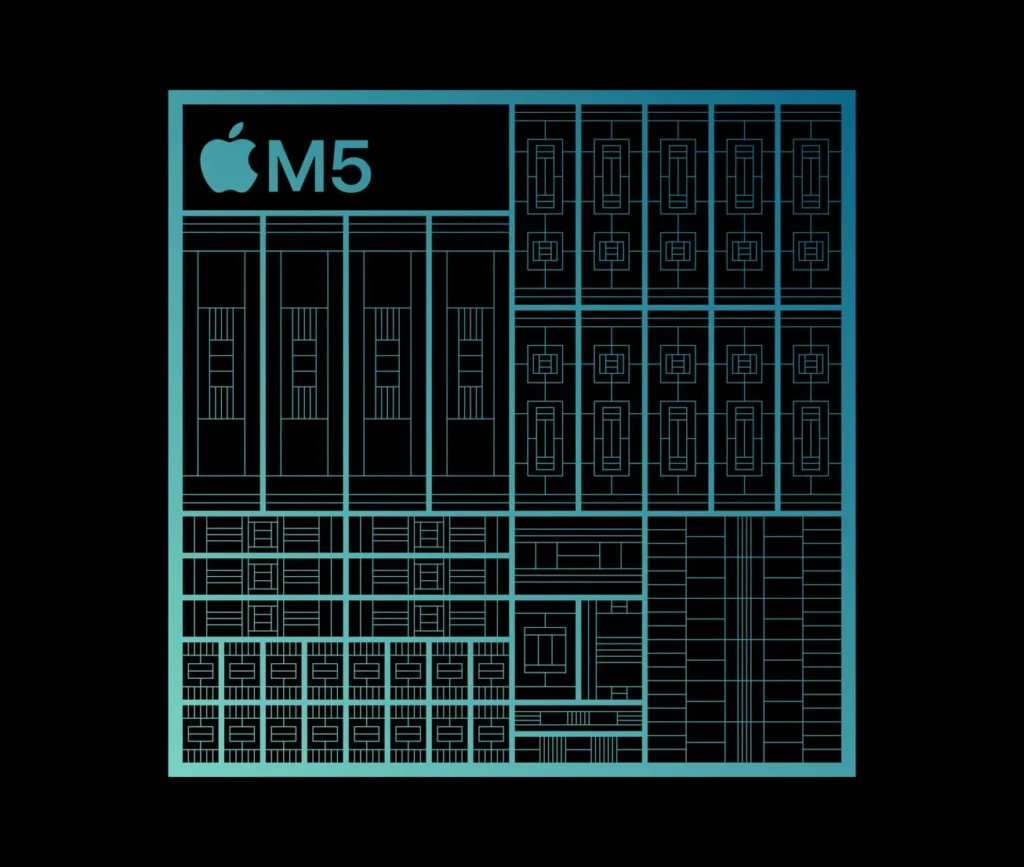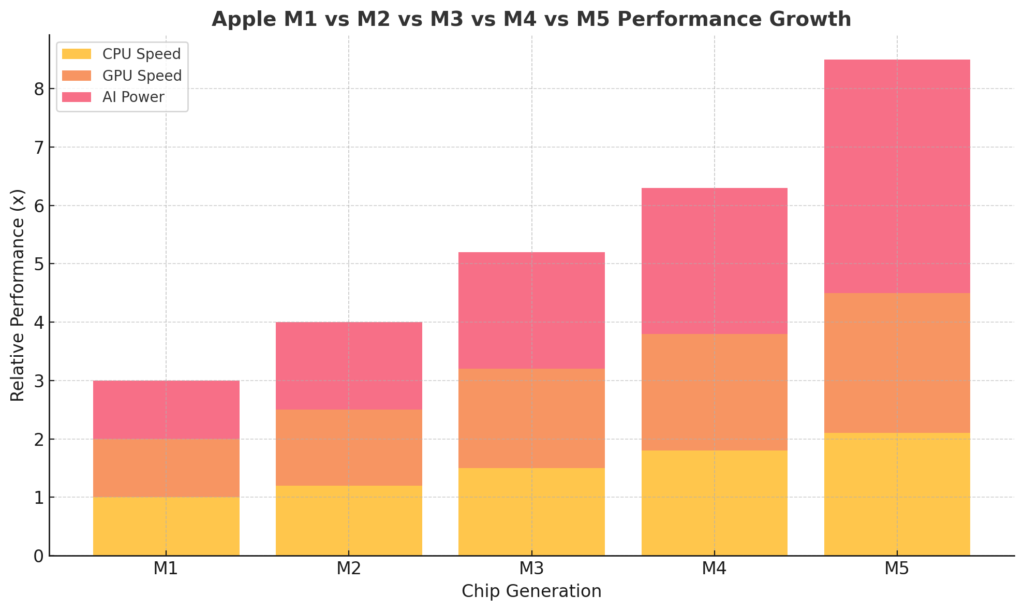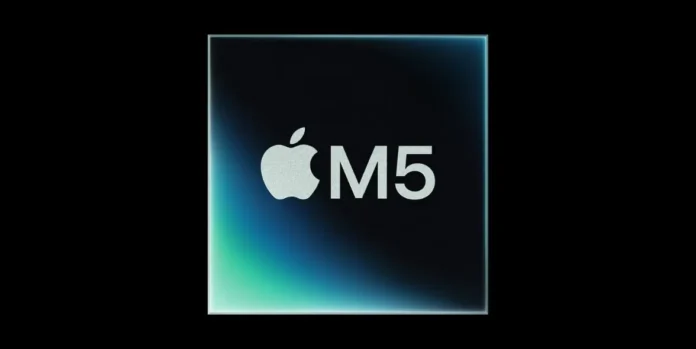Apple has officially launched the M5 chip, and it’s one of the most impressive upgrades we’ve seen in years.
This new chip takes Apple Silicon to the next level by combining advanced AI performance, faster processing, and incredible energy efficiency. It powers the latest MacBook Pro, iPad Pro, and Vision Pro, making each device smarter and more capable than ever before.
Based on Apple’s third-generation 3nm architecture, the M5 isn’t just a simple update. It represents a complete shift toward on-device intelligence. Whether you’re editing video, designing 3D visuals, or exploring AI tools, the M5 chip delivers faster, smoother, and smarter results.
At PCVenus, we also write about the Apple MacBook Pro M5 and how this chip transforms Apple’s laptops. You can read more about it on our site to understand how the M5 performs in real-world conditions.
Why the M5 Chip Matters for Apple Silicon
When Apple introduced the M1 chip in 2020, it changed how laptops and tablets handled performance and battery life. Macs became faster, cooler, and more efficient. Each new chip after that, including the M2, M3, and M4, made improvements in performance and graphics.
Now, the M5 chip focuses on something bigger. It brings AI acceleration directly into the hardware. This means the chip can process complex AI tasks right on the device without sending data to the cloud.
According to Johnny Srouji, Apple’s senior vice president of hardware technologies, “The M5 represents a major leap forward in Apple Silicon’s AI performance.“
This statement sums it up perfectly. This chip is designed to take Apple’s machine learning and AI tools, like Apple Intelligence, Core ML, and Vision Pro’s spatial computing, to a whole new level.
Apple is now building an ecosystem where Mac, iPad, and Vision devices share not just data, but also intelligence.
Apple M5 Chip Full Specifications
| Specification | Details |
|---|---|
| Processor Name | Apple M5 |
| Architecture | 3nm (third-generation 3nm, N3P process) |
| CPU Cores | 10-core CPU (4 performance cores + 6 efficiency cores) |
| CPU Performance | Up to 15% faster than M4, up to 6x faster than M1 |
| GPU Cores | 10-core GPU (redesigned with AI acceleration) |
| Neural Accelerators | 10 total (one per GPU core) |
| Neural Engine | 16-core Neural Engine (enhanced speed for AI tasks) |
| Unified Memory | Up to 32GB unified memory |
| Memory Bandwidth | 153GB/s |
| AI Performance | Up to 4x faster AI and machine learning speed compared to M4 |
| Graphics Performance | Up to 45% faster graphics rendering vs M4 |
| Fabrication Process | TSMC 3nm (Gen 3) |
| Supported Media Engines | H.264, HEVC, ProRes, and ProRes RAW hardware acceleration |
| Key Features | Third-gen Ray Tracing, Dynamic Caching, On-Device AI, Apple Intelligence Integration |
| Supported Devices | MacBook Pro (2025), iPad Pro (2025), Apple Vision Pro (2025) |
| Maximum Display Support | Up to 3 external displays (via MacBook Pro M5) |
| Energy Efficiency | Improved by up to 15% compared to M4 |
| Battery Life (on MacBook Pro) | Up to 24 hours |
| Launch Date | October 2025 |
| First Availability | MacBook Pro, iPad Pro, and Vision Pro (October 2025) |
Inside the M5: Neural Accelerators and GPU Upgrades
At the center of the M5 chip is a 10-core GPU that has been completely redesigned. Each GPU core now has its own Neural Accelerator, allowing it to handle AI tasks directly instead of depending on the CPU. This change lets the M5 perform AI and graphics tasks almost four times faster than the previous M4 chip.
This design makes a huge difference for developers and creators. Apps that use Apple’s Core ML, TensorFlow, or Foundation Models can now run with lower latency and better efficiency.
The GPU also introduces:
- Third-generation ray tracing for realistic graphics in games and creative apps
- Dynamic caching to automatically manage memory for complex workloads
- Optimized rendering for smoother visuals and real-time editing
If you work with 3D design, video editing, or AI-based image tools, the M5 will feel much faster and more responsive right away.
3nm Architecture for Speed and Efficiency
The Apple M5 chip is built using the latest 3-nanometer manufacturing process. This makes it more powerful and energy-efficient than any chip Apple has ever created.
It features a 10-core CPU with four high-performance cores and six efficiency cores. This setup delivers up to 15 percent faster CPU performance than the M4 and nearly six times faster performance than the original M1 chip.
Even with this speed increase, the M5 remains highly efficient. The chip strikes a balance between high power and low energy consumption, extending battery life and keeping devices cooler.
Faster Memory System
The M5 supports a unified memory bandwidth of 153GB/s, which is 30 percent more than the M4. It can also utilize up to 32GB of unified memory. This provides professionals with enough speed and capacity to run large AI models, edit high-resolution video, and multitask without lag.

AI Workflows That Benefit from the M5
The M5 chip was designed for users who depend on AI tools and creative workflows. It helps both professionals and developers complete demanding tasks faster.
For Creators
- Final Cut Pro and DaVinci Resolve render videos and apply color grading much faster.
- Adobe Photoshop uses AI tools like generative fill more efficiently.
- Logic Pro and GarageBand can apply AI-assisted mastering and audio effects in real time.
For Developers
- The M5 can train smaller machine learning models directly on the device.
- Siri and Apple Intelligence now respond instantly with lower latency.
- Vision Pro can turn 2D photos into full 3D spaces more quickly.
By combining AI acceleration and improved GPU performance, the M5 makes Apple devices capable of handling advanced tasks without cloud dependency.
Apple Intelligence: Smarter and More Private
The M5 chip powers Apple Intelligence, a system that brings smart features to macOS, iPadOS, and visionOS. These features are built to be fast, private, and integrated across all Apple devices.
Key features include:
- Image Playground for generating images from text or drawings
- Writing Tools that can summarize, rewrite, or improve content instantly
- Private Cloud Compute to keep personal data secure and encrypted
Apple also improved Siri, which now feels more natural and can connect with ChatGPT for deeper answers. The best part is that most of these tasks run locally on your device, protecting your privacy while keeping performance lightning fast.
Improved Memory, Multitasking, and Media Engine
The M5’s memory system allows the CPU, GPU, and Neural Engine to share a single high-speed memory pool. This means there’s no delay between components, so everything runs smoothly even with multiple apps open.
Creators can edit 8K ProRes video, render 3D models, and run AI tools simultaneously without interruption. Apple claims the new MacBook Pro M5 can last up to 24 hours on a single charge, even with mixed workloads.
The Media Engine also supports H.264, HEVC, and ProRes encoding. This reduces export times, keeps quality high, and power consumption low.

Apple M5 vs M4: What’s the Difference
| Feature | Apple M4 | Apple M5 |
|---|---|---|
| Architecture | 3nm Gen 2 | 3nm Gen 3 |
| CPU Cores | 10 (6E + 4P) | 10 (6E + 4P) |
| GPU Cores | 10 | 10 with Neural Accelerators |
| Neural Engine | 16-core | 16-core (improved) |
| Memory Bandwidth | 120GB/s | 153GB/s |
| AI Performance | Up to 2x faster | Up to 4x faster |
| Efficiency | Great | Even better |
The M5 is built for the future of AI. It improves everything from graphics to computing performance while keeping power use under control.
Devices with the M5 chip
The M5 chip powers the latest MacBook Pro (2025), iPad Pro (2025), and Vision Pro headset. Apple is expected to also make this chip available in the Mac mini and iMac in early 2026.
If you’re considering a new Apple device, the M5 version is the best choice. It’s ready for all the next-generation AI and creative apps coming soon.
Final Thoughts
The Apple M5 chip represents a major shift for Apple Silicon. It’s faster, smarter, and more efficient than any previous chip. Performance feels smoother in creative apps, AI tools, and multitasking, and its energy efficiency is impressive for this amount of power.
It still has some minor drawbacks. Since this is Apple’s first chip focused solely on AI, not all apps are able to take full advantage of it yet. New devices powered by the M5 come at a higher price, which may not appeal to every buyer. And while on-device AI is faster, Apple’s system is more closed-ended than other AI platforms.
Still, the M5 delivers what most users want: high performance, long battery life, and reliable speeds for creative and professional use. This is a smart move by Apple and a strong foundation for its AI-focused future.
Frequently Asked Questions
How much faster is the M5 than the M4?
The M5 delivers up to 15 percent faster CPU performance and nearly four times better AI performance than the M4.
Will all Macs get the M5 chip?
Not right away. The chip launches in the MacBook Pro, iPad Pro, and Vision Pro first, and it will expand to other Macs later.
Does the M5 improve battery life?
Yes. The M5’s energy-efficient design extends battery life up to 24 hours in the MacBook Pro M5.
Can the M5 run AI tools offline?
Yes. The chip is designed for on-device AI processing, so you can use most features without an internet connection.




